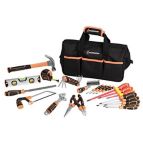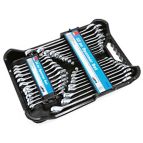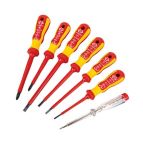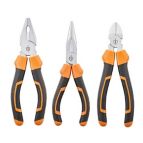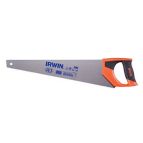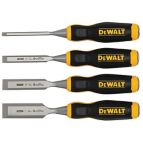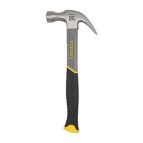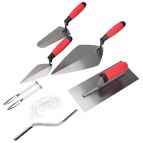Hand Tools Buying Guide
Hand Tools Buying Guide
Introduction
Whether you’re a professional tradesperson or DIYer, finding the right-hand tools for a home improvement or construction project is vital for making the job go smoothly.
In this hand tool guide, we look at what hand tools are used for and list the different types of hand tools available. We then advise on how to store and maintain hand tools, highlight things to consider before buying, and answer some frequently asked questions.
View our range of hand tools.
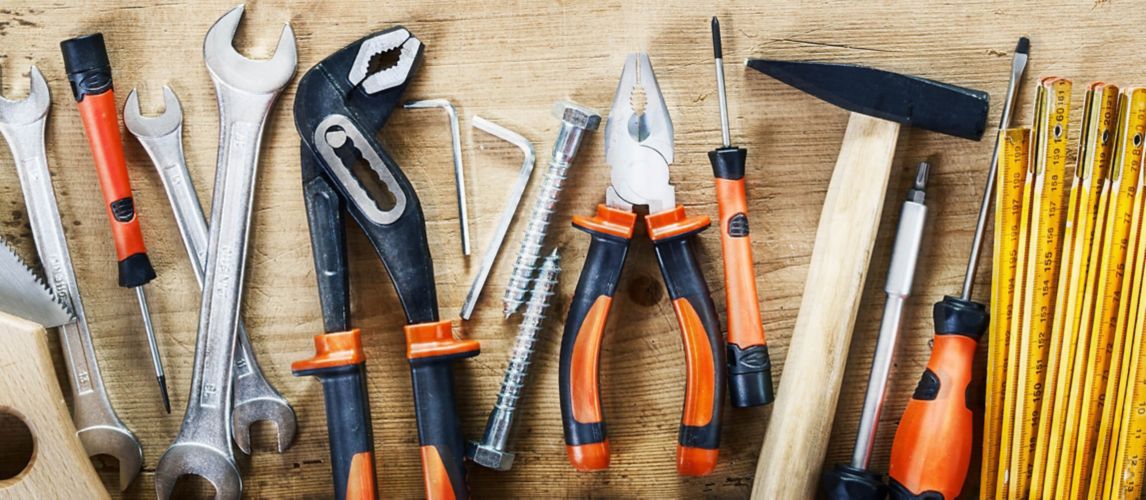
What are Hand Tools Used For?
Hand tools are equipment used to carry out manual tasks, such as hammering, screwing, sawing, cutting, and chiselling. Unlike power tools, they work without electricity or any other power.
Hand tools are an essential part of a toolkit for many. In the following sections, we’ll run through all the different types and highlight the top things to consider before buying each type.
Different Types of Hand Tools
Many types of hand tools are available that cover various tasks, from the most basic jobs around a home to large construction projects. There are hand tools to suit different materials, budgets, skill levels, and circumstances. For example, a tradesperson who uses a tool daily will need better quality and more robust tools than a DIYer who needs the same tool for an occasional or one-off task.
Sockets and Spanners Explained
Sockets and spanners are tools used to tighten and loosen nuts and bolts. The head of the tool grips the nut/bolt, and the handle acts as a lever to magnify the force being applied, thus creating torque to turn it. They’re most often used for plumbing, mechanical, and engineering tasks.
Different types of spanners and sockets available:
- Spanners grip nuts and bolts around the sides. Types of spanners include open-ended (gripping the nut/bolt on two sides), box-ended (gripping the nut/bolt all the way around) or combination (open-end on one side of the spanner and box-end on the other).
- Sockets are small pieces of metal that slot completely over the top of a nut or bolt. They attach to a ratchet handle which is turned to tighten or loosen the nut/bolt. There are different types of sockets available for different shaped fasteners or different jobs. For example, hex sockets are used with hex-shaped nuts/bolts, and spark plug sockets are explicitly used to fit or remove spark plugs from engines. Sockets are used primarily for mechanical tasks.
- Wrenches are also known as adjustable spanners. This is because they have two ‘jaws’, one of which can be moved in and out to adjust the head size.
Top things to consider
- When using a spanner, it’s essential the size matches the nut or bolt it’s being used on to ensure it gets a good grip. And, as nuts and bolts come in a wide variety of sizes, it’s best to buy a spanner set that includes a range of sizes. Alternatively, consider purchasing a wrench (adjustable spanner).
- Spanners can be measured in imperial or metric measurements, while some sets include both. So, always check the measurements to ensure you get a set that suits you.
- Spanners with long handles can help with tougher tightening or loosening requirements.
Screwdrivers and Hex Keys Explained
Screwdrivers and hex keys are must-have hand tools for every toolbox. Screwdrivers manually drive screws into various surfaces, while hex keys (also called Allen keys) are used to tighten and loosen bolts and screws with a hexagonal head.
Different types of screwdrivers and hex keys available:
-
Screwdrivers come in various sizes and head types to suit different screws. Types of screwdriver heads include slotted (with a flat bladed tip), Phillips (with a cross-head tip) and Torx (with a star-shaped tip).
-
Hex key types differ by the kind of head they have. Some have standard hex heads on both ends, and some have a standard hex head at one end and a ball-end on the other (useful for bolts at awkward angles). There are also hex keys with a hex-plus head, which has a holding function that securely holds the screw while turning it.
Top things to consider
-
Useful features available on some screwdrivers are a magnetised tip to help maintain contact with the screw and rubber-coated handles for additional grip.
-
For electrical work, look for screwdrivers with a VDE handle to prevent electric shocks.
Hand Saws and Cutting Tools Explained
Hand saws and cutting tools can be used for various small and large cutting tasks, from sawing through lengths of timber and sheet materials to cutting small holes and tree branches.
Different types of hand saws and cutting tools available:
Handsaws:
- Panel saws for cutting sheet materials and timber
- Hacksaws for cutting metal, wood, and plastic
- Junior hacksaws for cutting small materials such as plastic and metal pipes
- Bow saws for cutting tree branches and fallen branches
- Jab saws for cutting small, awkward holes in building materials, such as punching through plasterboard to fit pipes and electrics
- Tenon saws for cutting hard and soft woods. Commonly used to make tenons in mortise and tenon joints.
- Mitre saws for cutting mitre joints at a variety of angles. Commonly used to cut skirting boards, coving, and dado rails.
- Coping saws for cutting intricate shapes and curves in thin materials
- Pull saws for cutting fine mitre, dovetail cuts in wood
Knives:
- Utility knives for cutting a wide range of materials such as carpet and vinyl.
- Taping and jointing knives for drywalling applications, scraping and smoothing jointing compound.
Other cutting tools:
- Tin snips for cutting sheet metals
- Bolt cutters for cutting wires, chains, padlocks and bolts
- Scissors for making small cuts in a variety of thin materials
Top things to consider
- Different hand saw types have different amounts of teeth and different blade lengths to suit different materials and cuts. So, when choosing, consider the size of the material you are cutting and the type of cut you want (i.e., straight or shaped). You’ll need a long blade for large pieces of material. Also, consider the teeth per inch for the type of cut you want. The finer the cut, the more teeth you need.
- When buying knives, consider if you want a fixed or retractable blade. Fixed blades mean the knife is always ready when you need it, but a retractable blade will be safer if you place it loosely in a toolbox mixed with other tools.
- When buying scissors, there are different types designed for specific tasks. Always ensure you buy the right ones for the job, as using the wrong ones could damage the scissors and the item you are cutting.
- When buying bolt cutters, the longer the handle, the more leverage you’ll have to cut tougher, thicker metals.
Tiling Tools Explained
Tiling tools cover a wide range of products designed to ease and speed up the laying of floor and wall tiles. The right tools for tiling will result in a professional and quality finish. See our tiling tool guide for more detail.
Different types of tiling tools available:
- Tile cutters for cutting tiles to size
- Grouting tools include a grout float or spreader for applying new grout and grout remover tools that scrape away old grout from existing tiles.
- Tile spacers to place between tiles as they are laid to ensure even spacing
- Tiling trowels and spreaders for scooping, spreading, levelling, combing, and finishing tile adhesive.
- Tile nippers for making small straight or curved cuts in tiles that don’t require a larger cutter
Top things to consider
- Using tiles spacers is essential to allow for the movement of tiles after they are laid. But the size needed differs depending on the application. Wall spacers should be a minimum of 2mm, and floor spacers a minimum of 3mm.
- Tiling trowels and spreaders have notches on the blade, which come in different sizes. They differ by the distance between the notches and the depth of each notch. Generally, use a trowel with close and shallow notches for small tiles and wide and deep depth notches for large tiles.
Building Tools Explained
Building tools are used for a wide range of commercial and domestic projects. There are many different types of building tools available, from bricklayers tools including bricklayers trowels, to builders line and chalk, roofing tools, flooring tools, glazing tools, and paving tools. Read more about the different types of building tools and what to consider when buying building tools with our guide.
Hammers and demolition tools include hammers for driving in nails and knocking down walls, bolsters and cold chisels for breaking through hard materials, crowbars for removing nails and staples and forcing objects apart and axes for chopping through wood. See our hammer buying guide for more detail.
View our range of building tools and hammers and demolition tools.
Electrical Tools Explained
Electrical tools are designed for carrying out electrical installations, repairs, and maintenance tasks, as well as for testing electrical circuits to ensure they are safe.
Different types of electrical tools available:
- Electrical testers for assessing and evaluating equipment, wiring and devices to ensure they are safe
- Cable access tools and cable rods for routing cables over ceilings, under floors and through wall cavities or trunking
- Crimping tools for attaching connectors to the end of electrical cables. Some are also designed for bending, cutting and stripping cable
Top things to consider
- To protect you from accidental electric shocks, choose VDE electrical tools. These tools are often red and yellow in colour and are insulated from the tip to the end of the handle.
- When choosing cable rods, consider where and what material the cable needs to be pushed through. For example, 5mm rods are suitable for routing cable around bends, while 6mm rods can better deal with insulation materials.
Plumbing Tools Explained
Plumbing tools are designed for carrying out plumbing installations, repairs and maintenance tasks, and testing the mains water system.
Different types of plumbing tools available:
- Soldering and brazing tools, including blow torches and soldering irons, for joining pipes together
- Pipe cutters for quickly cutting pipes of differing materials and thicknesses
- Waterpump pliers for securely gripping nuts and bolts
- Drain cleaning tools for clearing clogged pipes
- Plumbing testing equipment for testing water pressure
- Pipe benders for shaping copper and steel pipes to create angles and bends
- Plumbing keys are used for a variety of applications such as opening maintenance hole covers, turning stopcocks, opening service cabinets and bleeding radiators
- Drain rods for unblocking drains
- Pipe freezing kits for freezing pipes so they can be worked on without draining the water system
- Plungers for unblocking waste pipes for toilets, sinks, baths and showers
- Tap reseaters for repairing leaking taps
Top things to consider
-
When choosing pipe benders, consider the degree of the angle you need and the diameter of the pipe you are working on, as different pipe benders work on different angles and materials.
Woodworking Tools Explained
Woodworking tools are specifically designed to help complete woodworking projects. They allow you to do the job efficiently and safely without making costly mistakes, leaving a professional finish.
Different types of woodworking tools available:
- Clamps and vices for securely holding the piece of material you are working on in place
- Wood chisels for intricately cutting, shaving and shaping wood
- Sawhorses and workbenches are used for supporting pieces of wood while you work on them
- Files and rasps for tidying and smoothing down rough edges on wood
- Wood planes for shaving and smoothing wood by shaving off thin layers
- Punching tools for creating an indentation in wood. Used for jobs such as creating a dimple in wood to allow nail heads to sit flush with the surface
- Sharpening stones used for sharpening chisels
- Surforms for shaving small strips of wood away to shape it. They can be used on small pieces instead of planes, files and rasps
- Spokeshaves for smoothing and shaping wood. Used for jobs such as rounding square wooden objects, e.g., chair legs and spindles
Top things to consider
- When buying clamps, look for features such as quick-release triggers and ergonomic handles. They also come in various sizes, have different clamping forces and can have plastic or steel jaws.
- When buying a chisel, ensure you get a chisel for wood, as there are also chisels available for metalwork and masonry. Also, pick a blade size depending on how intricately you need to cut or shape the wood. The smaller the blade, the more intricate the cut.
- When buying sawhorses, look for features such as being foldable for easy storage and having carry straps. If you need the sawhorse to support round items, choose a model which includes feature beams with additional grooves. Other design features include height adjustable legs and fold out support-arms.
Plastering Tools Explained
Plastering tools are tools for plastering walls. They are suitable for professional and DIY use and will help you coat a surface with a layer of plaster to any drywall.
Different types of plastering tools available:
- Plastering trowels for scooping and spreading plaster
- Featheredge and darby for smoothing and final finishing of plaster and levelling off plaster between two pieces of plasterboard
- Edging and joining tools include jointing and taping knives to smooth out plaster between joints in plasterboard, surform blocks for planing down and shaping plasterboard, scarifiers for scratching drywalls and external corner trowels for finishing plaster around corners
- Plastering hawk is used for carrying plaster from the mixing table to the surface
- Board and door lifters or lifting and holding plasterboard and doors in place
- Stilts to help you reach high places, such as ceilings, without the hassle of going up and down and constantly moving a ladder
Top things to consider
-
When buying a plastering trowel, be careful to choose the ideal trowel size. The size will affect your control, speed, and pressure when plastering.
How to Store Hand Tools
Hand tools are best stored in dedicated tool storage boxes. This helps keep them safe and easy to find when needed. But it also prevents the risk of injury from accidentally touching exposed sharp blades on tools such as saws, chisels, and planers.
There’s a wide variety of tool storage options available, and the type you choose will depend on the type and quantity of tools you need to store, whether for professional or personal use and the space available.
Types of tool storage include toolboxes, tool bags, and tool totes, which are perfect for DIYers or tradespeople who carry tools between different sites. There are organiser trays to keep small parts tidy and tool belts and holders for keeping tools on you while working. Large tool storage systems and chests are ideal for the serious DIYer or tradesperson who has lots of tools and works in one place. Vehicle and site safes are available to lock tools away to prevent theft. And finally, some tools come in ready-to-go tools kits, which include the tools and a storage case.
How to Maintain and Clean Hand Tools
To ensure hand tools are kept in excellent working condition, always ensure they are cleaned after every use and properly maintained.
How to maintain hand tools:
- Wipe them down with a rag to remove dust, grease, and debris after every use
- Periodically, lightly spray the metal parts of tools with an all-purpose oil such as WD40 to prevent corrosion and rust
- Ideally, keep tools in an area where there is minimal exposure to moisture and drastic temperature changes
- Sharpen bladed tools once per year, or more often depending on how frequently they are used
Key Considerations When Buying Hand Tools
The information above has hopefully given you a good overview of the different types of hand tools available and what they can be used for. But, before you buy, here are a few more things to consider:
-
What safety and protection do you need?
Most hand tools come with risks, so it’s essential to consider each tool, what the risks might be and how you can protect yourself and others. For example, some tools have sharp blades, and when they are used, they produce shooting debris and dust. So, wear PPE such as goggles, gloves, dust masks and protective clothing. -
What will it be used for?
Most hand tools are designed for specific tasks, and using the wrong one for a job could result in injury, damage to the tool or the item being worked on, or a poor finish. Always ensure you use the correct hand tool for the job to prevent this from happening. -
How often will the hand tool be used?
Before buying a hand tool, consider how often you’ll use it. If you’re buying it for a one-off job, a basic model will most likely be sufficient to get the job done. But if you’re a tradesperson who will use the tool frequently, ideally, get the best tool your budget will allow. Look for features that make the tool more comfortable for long periods or make the job easier. Also, look for quality tools made from durable materials. They will cost more but last longer than cheap tools, so they will be more cost-effective in the long run. -
Do you have tool storage?
If you’re buying new tools and don’t already have somewhere safe to store them, consider investing in tool storage. Keeping tools in a toolbox will protect them from damage and prolong their life. It also means your tools will be organised and tidy, and you’ll always know where to find them when you need them. -
Have you got cleaning supplies and preparation equipment for use with hand tools?
Using hand tools often creates a lot of mess, and there’s usually a certain amount of prepping that needs to be done beforehand too. So, it’s helpful to be prepared. Consider buying cleaning and preparation equipment such as rubble sacks, plastic flexi tubs, tarpaulin, buckets, pens, and pencils before you start. View our range of cleaning prep.

